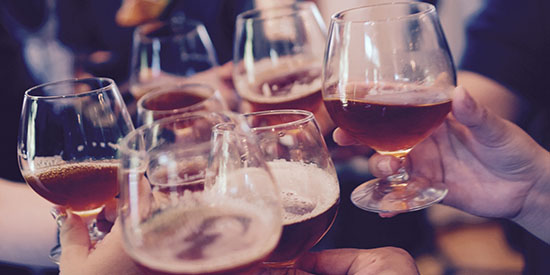How do I know I'm drinking too much this silly season: Deakin can tell you
Media releaseWith Christmas party season in full swing, and New Year's Eve just round the corner, it can be easy to overindulge on the alcohol front, but how much is too much over the silly season?
Psychologist and public health expert, Dr Bosco Rowland, from Deakin's School of Psychology, said it was common knowledge that many people upped their alcohol intake over the summer period, so it was a timely to remind ourselves the health guidelines around excessive drinking.
"Alcohol is common way many societies stimulate social interaction, none more so than to break the ice of awkward small talk at work Christmas parties," Dr Rowland said.
"But when consumed at high levels over long periods it can undermine physical health and cause cancers and other disease."
Common signs you’re drinking too much include:
- Waking up with dry eyes – Alcohol dries you out, so if you're regularly waking up with dry eyes maybe look at how much booze you’re drinking;
- Needing to get up for the toilet multiple times in the night – Alcohol can act as a diuretic, and those aged under 65 should not need to get up in the night for the bathroom;
- Craving a drink in the afternoon – Self medicating with alcohol is an especial risk for people at risk of depression or anxiety, but alcohol is a depressant so it can just make things worse.
- Broken sleep, leaving you grumpy and forgetful – Alcohol stops Rapid Eye Movement (REM) sleep, the most active part of sleep, where we do most of our dreaming and which is really important for helping our brain process mood and for memory;
- An upset stomach – Problems with your liver can affect your digestion of food;
- Needing to drink more and more alcohol to feel its effects – This is a sign your body has learnt to work harder to breakdown alcohol quicker, but while it may blind you from the short-term effects, the long-term consequences like liver disease will only worsen; and
- Yellowing of the whites of your eyes – This is the easiest way to detect jaundice, a key sign of an upset liver.
If you feel some of these signs might apply to you, it's a good idea to speak to your GP.
So how much is safe to drink?
Dr Rowland said the National Health and Medical Research Council set Australian drinking guidelines, which contain four recommendations to ensure our drinking is "low risk".
"Low risk is defined as drinking at a level that reduces the chance an individual will suffer from short-term injury or long-term disease," he said.
"Healthy men and women are advised not to drink more than two standard drinks on any one day. If a person drinks less than that, the probability he or she will suffer from long-term alcohol-related disease (such as cancer) is approximately one in 100. There are approximately 70 cancers causally linked to alcohol consumption.
"For both men and women, drinking no more than four standard drinks on a single occasion reduces the risk of alcohol-related injury to one in 100. Risk of injury includes physical injury, or road accidents due to impaired cognitive performance and diminished reaction times."
Dr Rowland said health-conscious partygoers could try a few strategies to cut down over summer.
"Start by ensuring you are having at least one to two alcohol-free days," he said.
"When going to functions where alcohol will be available, have a strategy rehearsed in your mind as to how and why you will not consume, or moderate your alcohol consumption. You may say it is one of your alcohol-free days, you are not drinking today, or you are pacing yourself this week.
"You can also try mixing or diluting drinks with something non-alcoholic, such as a white wine spritzer or a shandy.
"Hosting Christmas parties somewhere outside and encouraging physical activity can also reduce the impulse to reach for the bottle. A beach party or barefoot bowls are great alternatives to the local pub, especially with our warm summer weather."

